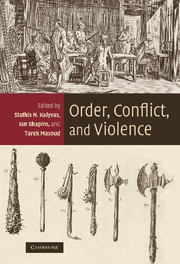Book contents
- Frontmatter
- Contents
- List of figures
- List of tables
- List of contributors
- Preface
- 1 Introduction: integrating the study of order, conflict, and violence
- Part 1 Creating, maintaining, and restoring order
- Part 2 Challenging, transforming, and destroying order
- 8 Civil wars and guerrilla warfare in the contemporary world: toward a joint theory of motivations and opportunities
- 9 Clausewitz vindicated? Economics and politics in the Colombian war
- 10 Articulating the geo-cultural logic of nationalist insurgency
- 11 Which group identities lead to most violence? Evidence from India
- 12 Order in disorder: a micro-comparative study of genocidal dynamics in Rwanda
- 13 Sexual violence during war: toward an understanding of variation
- 14 “Military necessity” and the laws of war in Imperial Germany
- 15 Preconditions of international normative change: implications for order and violence
- 16 Promises and pitfalls of an emerging research program: the microdynamics of civil war
- Index
- References
13 - Sexual violence during war: toward an understanding of variation
Published online by Cambridge University Press: 06 July 2010
- Frontmatter
- Contents
- List of figures
- List of tables
- List of contributors
- Preface
- 1 Introduction: integrating the study of order, conflict, and violence
- Part 1 Creating, maintaining, and restoring order
- Part 2 Challenging, transforming, and destroying order
- 8 Civil wars and guerrilla warfare in the contemporary world: toward a joint theory of motivations and opportunities
- 9 Clausewitz vindicated? Economics and politics in the Colombian war
- 10 Articulating the geo-cultural logic of nationalist insurgency
- 11 Which group identities lead to most violence? Evidence from India
- 12 Order in disorder: a micro-comparative study of genocidal dynamics in Rwanda
- 13 Sexual violence during war: toward an understanding of variation
- 14 “Military necessity” and the laws of war in Imperial Germany
- 15 Preconditions of international normative change: implications for order and violence
- 16 Promises and pitfalls of an emerging research program: the microdynamics of civil war
- Index
- References
Summary
While sexual violence occurs in all wars, its extent varies dramatically. During the conflict in Bosnia-Herzegovina, the sexual abuse of Bosnian Muslim women by Bosnian Serb forces was so systematic and widespread that it comprised a crime against humanity under international law. In Rwanda, the widespread rape of Tutsi women comprised a form of genocide, according to the International Criminal Tribunal for Rwanda. Yet sexual violence in some conflicts is remarkably limited despite other violence against civilians. Even in some cases of ethnic conflict, sexual violence is limited; the conflicts in Israel/Palestine and Sri Lanka are examples. Some armed groups, such as the Salvadoran and Sri Lankan insurgencies, appear to effectively prohibit their combatants engaging in sexual violence against civilians.
The form of sexual violence varies as well. In some conflicts, it takes the form of sexual slavery; in others, state agents engage in sexualized torture of persons suspected of collaborating with insurgents; in others, combatants target women of particular groups during ethnic or political cleansing; in still others, individuals engage in it opportunistically; and in some conflicts, all or nearly all forms occur. In some wars, women belonging to particular groups are targeted; in others, the attacks are much less discriminate. In some wars, only females are targeted; in others, males are as well. Some acts of wartime sexual violence are committed by individuals; many are committed by groups. Some acts occur in private settings; many are public, in front of family or community members.
- Type
- Chapter
- Information
- Order, Conflict, and Violence , pp. 321 - 351Publisher: Cambridge University PressPrint publication year: 2008
References
- 29
- Cited by

